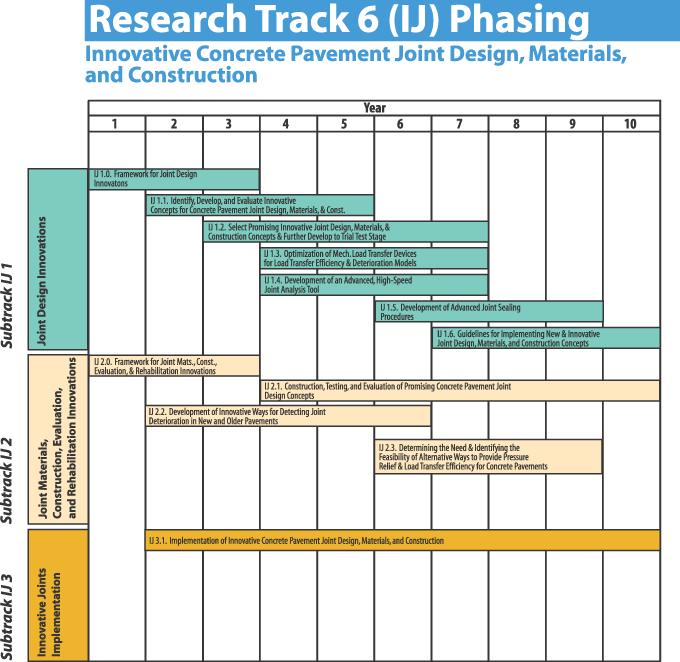U.S. Department of Transportation
Federal Highway Administration
1200 New Jersey Avenue, SE
Washington, DC 20590
202-366-4000
Federal Highway Administration Research and Technology
Coordinating, Developing, and Delivering Highway Transportation Innovations
 |
| This report is an archived publication and may contain dated technical, contact, and link information |
|
Publication Number: FHWA-HRT-05-053 Date: September 2005 |

Figure 6. Track 6 (IJ) subtrack and problem statement phasing chart.
Track 6 (IJ) subtrack and problem statement phasing chart.The horizontal bar chart in this figure shows the approximate time phasing of the problem statements in track 6, Innovative Concrete Pavement Joint Design, Materials, and Construction (IJ), grouped by subtrack across 10 years. There are three subtracks in track 6: (1) Joint Design Innovations; (2) Joint Materials, Construction, Evaluation, and Rehabilitation Innovations; and (3) Innovative Joints Implementation.
In subtrack 1 the problem statements are arranged as follows: Problem Statement IJ 1.0. Framework for Joint Design Innovations extends from years 1 to 3; Problem Statement IJ 1.1. Identify, Develop, and Evaluate Innovative Concepts for Concrete Pavement Joint Design, Materials, and Construction extends from years 2 to 5; Problem Statement IJ 1.2. Select Promising Innovative Joint Design, Materials, and Construction Concepts and Further Develop to Trial Test Stage extends from years 3 to 7; Problem Statement IJ 1.3. Optimization of Mechanical Load Transfer Devices for Load Transfer Efficiency and Deterioration Models extends from years 4 to 7; Problem Statement IJ 1.4. Development of an Advanced, High-Speed Joint Analysis Tool extends from years 4 to 7; Problem Statement IJ 1.5. Development of Advanced Joint Sealing Procedures extends from years 6 to 9; and Problem Statement IJ 1.6. Guidelines for Implementing New and Innovative Joint Design, Materials, and Construction Concepts extends from years 7 to 10.
In subtrack 2 the problem statements are arranged as follows: Problem Statement IJ 2.0. Framework for Joint Materials, Construction, Evaluation, and Rehabilitation Innovations extends from years 1 to 3; Problem Statement IJ 2.1. Construction, Testing, and Evaluation of Promising Concrete Pavement Joint Design Concepts extends from years 4 to 10; Problem Statement IJ 2.2. Development of Innovative Ways for Detecting Joint Deterioration in New and Older Pavements extends from years 2 to 6; and Problem Statement IJ 2.3. Determining the Need and Identifying the Feasibility of Alternative Ways to Provide Pressure Relief and Load Transfer Efficiency for Concrete Pavements extends from years 6 to 9.
Subtrack 3 contains only one problem statement: Problem Statement IJ 3.1. Implementation of Innovative Concrete Pavement Joint Design, Materials, and Construction extends from years 2 to 10.